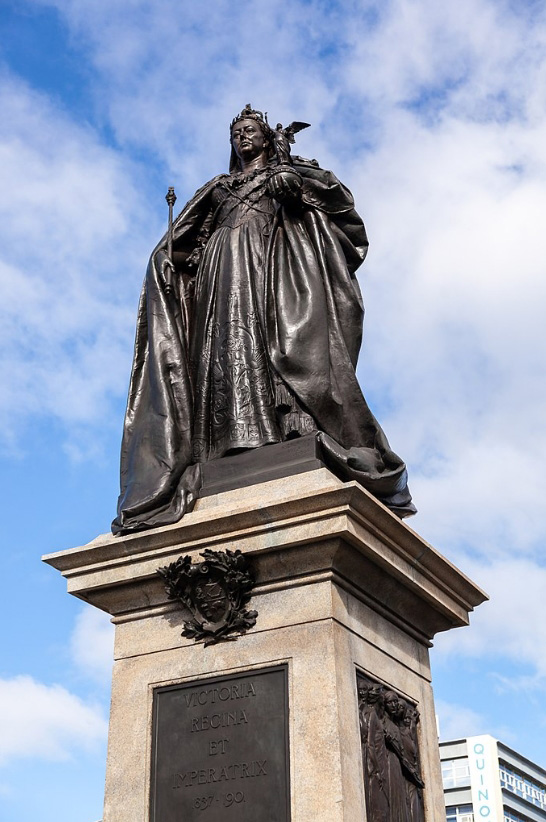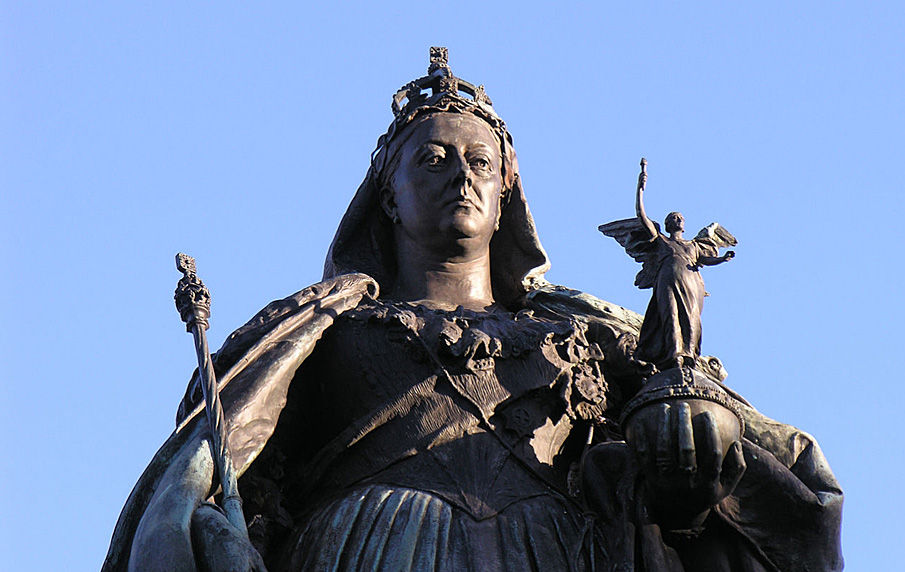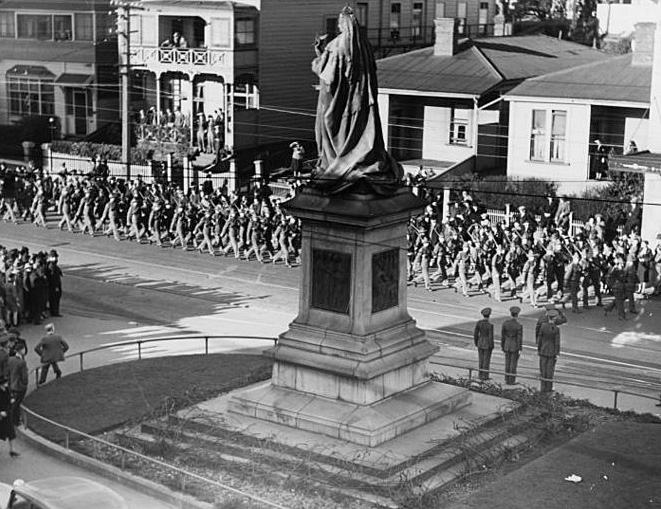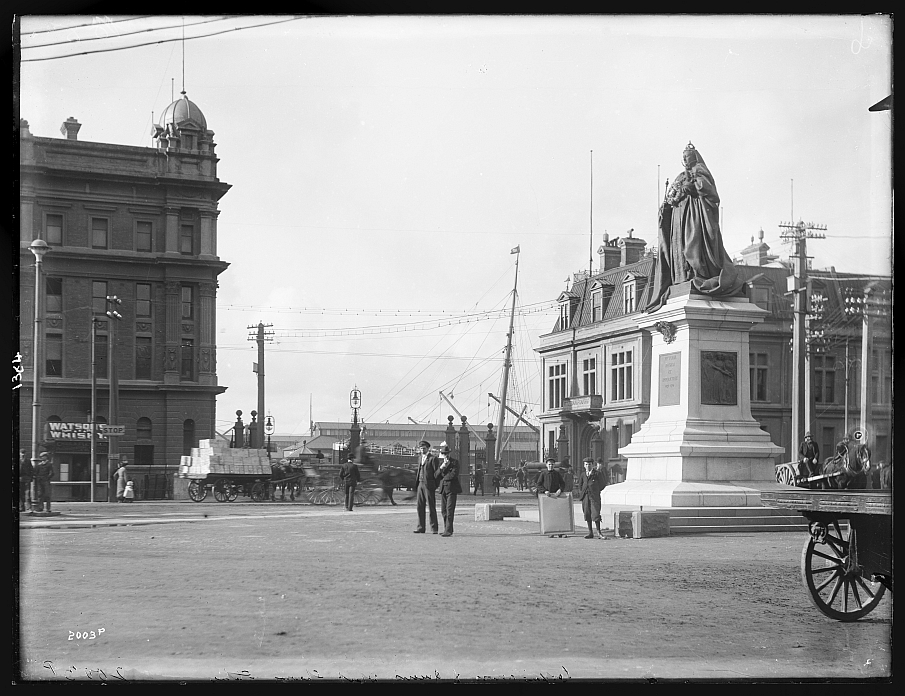The Queen Victoria Monument, now situated between Kent and Cambridge Terraces in Wellington, is a posthumous memorial commemorating the monarch Queen Victoria, who reigned from 1837 to 1901. For Wellington, the Queen has special significance as the much of the planning and building of the city occurred during her reign. The Queen Victoria Monument was planned in the days following the death of the monarch on the 22 January 1901. The monument was originally intended as a national memorial but this idea was rejected after considerable public outcry (particularly from the South Island) against being forced to contribute to a monument many would never see. As a result, Prime Minister Richard John Seddon (1845-1906) decided to act on behalf of only the citizens of Wellington. He set about informing William Pember Reeves (1857-1932) to begin the search for an artist who could create a ‘creditable statue for the sum of ₤3000’ all of which would be public donation. Reeves contacted several English newspapers to advertise the proposal; he was wary of setting up a competition as first class artists often did not compete. The commission was finally won by Alfred Drury (1856-1944) in late 1902. Drury began work on the monument in 1903, creating it in two pieces. The bronze statue of the Queen portrays the monarch wearing the robe of state, with the customary small crown over her widow’s veil. She carries the sceptre and an orb surmounted with a personified winged Victory. Her gown is embroidered with decorative details of national emblems. The pedestal was made from Aberdeen granite. It is decorated with four bronze reliefs showing the artist’s representations of the signing of the Treaty of Waitangi, Fine Arts and Literature and the inventions of Queen Victoria’s reign. The fourth bears an inscription in Latin-VICTORIA REGINA ET IMPERATRIX 1837-1901, Victoria Queen and Empress 1837-1901. The bronze pedestal reliefs have been the subject of heated debate since their creation, mainly due to the representation of the signing of the Treaty of Waitangi. Drury’s attempt to create a dignified but believable scene has been interpreted in a range of ways from a ‘striking artwork’ to a ‘triumphalist gloss over the events of 1840’. The detailing found on these reliefs is remarkable, with Drury including small wheels on the locomotives on the ‘inventions’ relief and individual moko on the chiefs on the relief depicting the Treaty. Getting the monument finished was easier said than done. Many artists had been commissioned to create statues of Queen Victoria for her Diamond Jubilee and on her death. This meant the casting of the main statue and reliefs for the Wellington monument were delayed due to a large backlog of work at the foundry. The reliefs were not finished in time for the unveiling. The Queen Victoria Monument was unveiled on the 29 April 1905 by Governor Sir William Plunket (1864-1920) in Post Office Square. Plunket believed that the monument held the significance of a mini Statue of Liberty for immigrants arriving at the harbour. Though Post Office Square seemed well suited for the monument, it was relocated in 1911 to a site between Kent and Cambridge Terraces. The reasons behind this relocation are not well defined, but it seems that the decision to relocate the statue was made due to traffic issues in the Jervois Quay area and the introduction of new electric trams. In its new location, the statue is exposed to heavy traffic and exhausts fumes, and views of the Monument are blemished by the presence of bus and power lines. Attempts have been made to relocate the monument back to its original site in Post Office Square but have failed following protest from local residents and businesses. The Queen Victoria Monument is a significant piece of Wellington history and an example of artistic and technical skill. The monument is important to many people in Wellington as a fascinating, enduring and beautiful expression of the values that were held in New Zealand’s colonial past. As a potent symbol of colonisation and Victorian morality, it has also been the site of protest. For example, in 1977 it was the site of a demonstration in support of lesbian visibility on International Women's Day.





Location
List Entry Information
Overview
Detailed List Entry
Status
Listed
List Entry Status
Historic Place Category 2
Access
Able to Visit
List Number
3663
Date Entered
6th June 1984
Date of Effect
6th June 1984
City/District Council
Wellington City
Region
Wellington Region
Extent of List Entry
Registration includes the part of the land described as Pt Canal Reserve Town of Wellington, Wellington Land District and the structure known as the Queen Victoria Monument and pedestal thereon.
Legal description
Pt Canal Reserve Town of Wellington, Wellington Land District
Location Description
Situated between Kent and Cambridge Terraces, Wellington.
Stay up to date with Heritage this month
